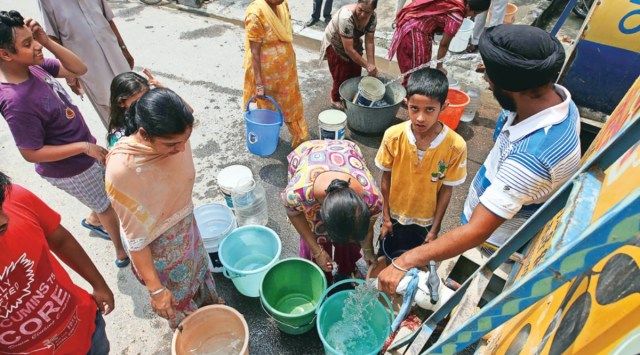No overhead water tanks in Chandigarh from next year
“Everything would be technologically controlled. In our control centre – the SCADA, even if there is any leakage in the pipeline of a particular house owner, our system
 Residents filling buckets amid water shortage. File
Residents filling buckets amid water shortage. File Overhead tanks will be phased out from January 2024 as taps will provide drinking water in Chandigarh. Since average per person consumption in Chandigarh – 245 litre per day – is way higher than the national standard norm of 135 litre per day, the union territory (UT) aims to bring the usage down to 150 litre per day.
The move is part of the 24×7 water supply project in Chandigarh, which also aims to fix the leakage issues. Chandigarh loses up to 35 per cent drinking water in the leakages and other issues, and to resolve this problem, district metering areas (DMAs) would be formed so as to ensure there is no leakage.
 man filling a water tanker. Chandigarh municipality commissioner Aninidita Mitra said since taps will begin giving drinking water in the city, the civic body would phase out overhead tanks at residences. All tube wells, too, will be shut down in a phased manner. File
man filling a water tanker. Chandigarh municipality commissioner Aninidita Mitra said since taps will begin giving drinking water in the city, the civic body would phase out overhead tanks at residences. All tube wells, too, will be shut down in a phased manner. File
“Everything would be technologically controlled. In our control centre – the SCADA, even if there is any leakage in the pipeline of a particular house owner, our system
will start showing a red flicker, and the resident will be informed. We can even turn off the water supply with the press of a button of a particular sector also,” Chandigarh Municipal Commissioner and Smart City Chief Executive officer Aninidta Mitra told The Indian Express.
Mitra said residents usually complain that their water bills are showing escalated charges without realising that there are leakages in the pipeline of their houses. “So, it has become highly important to fix these leakages,” the commissioner added.
She also said since the tap water would begin giving drinking water, they would phase out the overhead tanks in residence, adding that “all the tube wells will be shut down in a phased manner, and only canal water will be supplied for the next 30 years.”
“Because, the tap would be supplying the drinking water, our next move is to begin phasing out the overhead tanks and tubewells. The best outcomes of the project would be clean drinking water, 24×7, early detection of leakages leading to speedy redressal, and minimal wastage of water,” she added.
The commissioner also said the project will help them bring down the leakages from 35 per cent to 15 per cent.
Criss-cross pipeline: A troublemaker
Currently, it takes several days or weeks to detect leakages as water pipelines in the UT are laid in a criss-cross form. As these pipelines are now very old, they would be replaced under the project.
The services like Water Supply and Sewerage systems were also laid in 1952 with the development of Chandigarh as a planned city. In the first phase, pipelines were laid in 1952-1970 (Sector 1 to 30). In the second phase (1970-1983), Sectors 31 to Sector 47 were covered, and in the third phase (1983- 2006) Sectors 48 to 56 & Sector 63 got the pipelines.
How are pipelines laid
The rising mains go along V1, V2 and V3 roads, whereas distribution lines are in V4, V5 and V6. The size of the distribution network and rising main varies from 75 mm to 1200 mm. The material of the pipes is CI/DI/PSC. There are ten water works including mother water works at Sector 39 that has been established to supply the water supply to the entire city. Water works have been designed to supply the water up to 2.5 floors.
The water scenario
At present, there is intermittent water supply that is being supplied in the morning and evening to residents. The timing of water supply is 4 am to 9 am, and in evening from 5 am to 9 am. There are two sources of water – groundwater and canal water.
The canal water from Kajauli comes to Chandigarh through six phases and each phase supplies 14.5 mgd water to city. About 75 mgd canal water is being received and 20 mgd water is received through 300 tube wells to meet the demand of city.
First city with district metering system?
Chandigarh would probably be the first city in the country to introduce the district metering system – a technique that will be used to improve the management of water distribution system (WDS).
The entire Chandigarh has been divided into six zones (excluding Manimajra) which are being fed by water works of Sector 12, 26, 32, 37 and 52. All these water works are fed by Sector 39 water works, which is known as the mother feeder. Existing Six zones are further divided into DMAs – district metering areas with respect to existing water works feeding area.
“(DMA) is defined as a discrete area of a water distribution network. It is usually created by closing boundary valves so that it remains flexible to changing demands. Each Sub-DMA will consist of one complete sector. Each sector can be properly managed only if it is considered as an individual DMA. Water flowing of the DMA is metered and flows are periodically analysed in order to monitor the level of leakage. A total number of 55 DMAs have been proposed, which will be clubbed to form the six supply zones,” Mitra explained.
The system includes partitioning a WDS into smaller portions called DMAs. These “districts” are formed by placing and closing isolation valves along certain pipes connecting one DMA to another (closed links) and placing a flow meter in the remaining connecting pipes (open links).
Based on the measured inflow and outflow of each DMA and taking into account storage, the Chandigarh civic body shall be able to determine the water balance of the DMA and even monitor minimum night flows. Through this system, the civic body will get to know about any leakage present in the said district.
With real time system management, the civic body has also ensured that each district is of adequate size, i.e. sufficient users or inhabitants.








